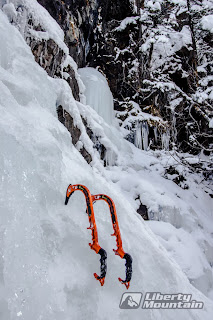It has always been of my opinion that ice climbers are tough-guys. So much so that I place them a bit higher on the Scale-O-Toughness than rock climbers? Why is that?
It has nothing to do with prejudice…I’m not even an ice climber. I’ve spent the last 10+ years exclusively climbing rock, never once swinging an axe or kicking a ‘pon. I’ve even dodged countless invitations to go out and “slay some ice” because I had yet to find interest in it.
So then why would I place ice climbers on a higher pedestal than myself? Isn’t ice climbing just a winter version of rock climbing? Isn’t an ice climber just a refrigerated version of a rock climber?
On my recent trip to the 2013 Bozeman Ice Climbing Festival, I got to personally experience ice climbing for the first time. I found myself in a deluge of ice aficionados, ranging from timid beginners to world-class athletes. It was then that I was finally able to observe ice climbers in their natural habitat and was able to justify my opinion about ice climbers.
Here are some of my discoveries:
They climb ICE, i.e., they climb something that breaks, cracks, shatters, and melts. They don cuts and bruises on their faces from the shards and blocks of ice that hit them in the face. They prefer to climb “plastic” ice, ice that is in the process of melting. They anchor themselve to the ice using screws
They climb with SHARP OBJECTS, i.e., they climb with tools that can impale their bodies and sever their ropes. They look like a weapon-slinging Hun whenever they walk up to the base of a route. They look like Indian Fakirs every time they go in and out of a Figure-4 and appear as swashbuckling pirates whenever they bite their ice tools.
They climb when the temps are BELOW FREEZING, i.e., they climb outside when everyone else is in the gym pulling on plastic. They proactively set themselves up for reoccurring cases of the “screaming-barfies.”
They hike SNOW COVERED APPROACHES, i.e., they rarely find themselves at a roadside crag or on a dry trail. They consider post-holing in the snow for 2 miles as their warm-up for one frozen waterfall.

Their ROUTES DON’T ALWAYS EXIST, i.e., their routes change in grade, size, and safety in a matter of days or even hours. Each one of their routes has its own season—climb it now or wait till it forms again in 2-20 years.
They carry HEAVY PACKS, i.e., they carry all the standard climbing gear, as well as all the metal ice gear and extra pairs of clothing needed for a sub-zero adventure. They pack gear for the approach, gear for the belay, and gear for the climb.
In conclusion, ice climbers deserve to be called tough-guys…and gals. They chase elusive ice. They brave the cold. They climb the unpredictable.
Now I have to decide if I want to raise my personal position on the Scale-O-Toughness by taking up ice climbing…
Liberty Mountain represented Grivel at the 2013 Bozeman Ice Climbing Festival as the Beer Sponsor, Demo Gear Sponsor, and a Clinic Sponsor. Grivel ice tools, crampons, screws, and helmets were available for demoing, Grivel athletes, Aaron Mulkey and Scott Adamson conducted clinics, and everyone was hydrated with bottomless pint glasses. To top it all off, Angelika Rainer, an international Grivel athlete placed first in the female cateagory of the UIAA Open North American Ice Climbing Championships. For more photos from the Bozeman Ice Fest, visit our Facebook page.
Photos by Benjamin Eaton.
_________
Subscribe to our RSS feed for future articles. SUBSCRIBE NOW.
Like what you read? Share it with a friend.





















1 comment:
While vertical rock climbing and vertical ice climbing might be asked to reach the surface of a mountain, not all mountains require the same sort of climbing methods to get to the summit. For more information on Climbers Den read here.
Post a Comment